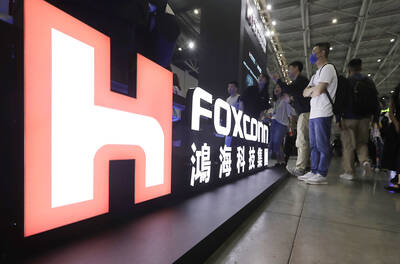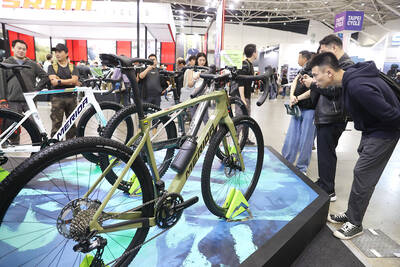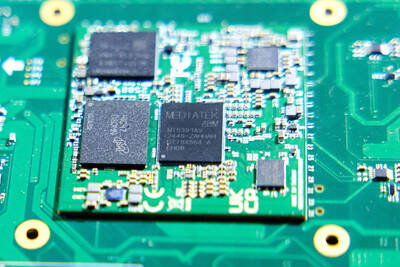Powerchip Technology Corp’s (力晶科技) shift away from the volatile DRAM business over the past two years has borne fruit, with the company emerging as the world’s sixth-largest wafer foundry last year, a report released last week showed.
Taiwan Semiconductor Manufacturing Co (TSMC, 台積電) remained the world’s top foundry, the report by IC Insights Inc showed.
Powerchip saw foundry sales jump to US$1.175 billion last year, up 88 percent from US$625 million in 2012 and more than three times the US$374 million it made in 2011.
The Hsinchu-based company took a 2.74 percent share of the global foundry market last year against a 1.66 percent share in the previous year, IC Insights said.
“Slowly but surely the company has transformed itself into a major IC foundry,” the Scottsdale, Arizona-based semiconductor researcher said of Powerchip’s decision in 2011 to sell all of its DRAM output to Japan’s Elpida Memory Inc.
Powerchip reported last month that it swung into profit last year after it shifted its focus to producing other items, such as LCD driver chips, complementary metal oxide semiconductor (CMOS) image sensors, flash memory chips and power management devices for self-branded products and on a foundry basis for others.
Net income reached NT$10.7 billion (US$352.3 million) last year, or earnings per share of NT$4.84, the highest since 2005, on consolidated revenue of NT$36.23 billion. In 2012, the company posted a net loss of NT$20.13 billion, or a net loss per share of N$9.09, on revenue of NT$31.77 billion.
The IC Insights report reaffirmed TSMC’s leading role in the global foundry sector, with sales of US$19.85 billion last year and a market share of 46.33 percent — ahead of GlobalFoundries Inc and United Microelectronics Corp (UMC, 聯電).
TSMC’s sales were more than four times higher than those of the US-based GlobalFoundries, whose sales grew 6.18 percent annually to US$4.26 billion, and five times the US$3.959 billion its Taiwanese rival, UMC, made last year.
Vanguard International Semiconductor Corp (世界先進) and Win Semiconductors Corp (穩懋) were the other two Taiwanese companies on the top 13 list compiled by IC Insights, ranking 7th and 13th respectively.
Overall, the five Taiwanese foundries secured about 60 percent of the global market last year. The remaining 40 percent went to three South Korean companies (Samsung Electronics Co, Dongbu Electronics and MagnaChip Semiconductor), two each from China (Semiconductor Manufacturing International Corp, 中芯, and Hua Hong Grace Semiconductor Corp, 華虹) and the US (GlobalFoundries and IBM Corp), and Israeli chipmaker TowerJazz Semiconductor, among others.
IC Insights said Samsung’s aggressive moves in the foundry business could threaten the position of No. 3 UMC.
Ranked fourth last year, Samsung witnessed a 14.86 percent increase in foundry sales to US$3.95 billion — just US$9 million less than UMC’s, the report showed.
“Samsung has the ability and desire to become a major force in the IC foundry business,” IC Insights said, adding that the company has the potential to generate annual foundry sales of about US$5.4 billion.
Backed by growing demand for chips used in mobile devices, such as smartphones and tablets, the global foundry sector saw total sales increase 14.98 percent to US$42.84 billion last year, with the 13 leading firms contributing combined sales of US$38.92 billion, or 91 percent of the total.
With higher barriers to entry into the foundry business in terms of fab costs and access to advanced technology, IC Insights expects the top 13 foundries to see their market share continue rising in the future, albeit slowly.

On Ireland’s blustery western seaboard, researchers are gleefully flying giant kites — not for fun, but in the hope of generating renewable electricity and sparking a “revolution” in wind energy. “We use a kite to capture the wind and a generator at the bottom of it that captures the power,” said Padraic Doherty of Kitepower, the Dutch firm behind the venture. At its test site in operation since September 2023 near the small town of Bangor Erris, the team transports the vast 60-square-meter kite from a hangar across the lunar-like bogland to a generator. The kite is then attached by a

Foxconn Technology Co (鴻準精密), a metal casing supplier owned by Hon Hai Precision Industry Co (鴻海精密), yesterday announced plans to invest US$1 billion in the US over the next decade as part of its business transformation strategy. The Apple Inc supplier said in a statement that its board approved the investment on Thursday, as part of a transformation strategy focused on precision mold development, smart manufacturing, robotics and advanced automation. The strategy would have a strong emphasis on artificial intelligence (AI), the company added. The company said it aims to build a flexible, intelligent production ecosystem to boost competitiveness and sustainability. Foxconn

Leading Taiwanese bicycle brands Giant Manufacturing Co (巨大機械) and Merida Industry Co (美利達工業) on Sunday said that they have adopted measures to mitigate the impact of the tariff policies of US President Donald Trump’s administration. The US announced at the beginning of this month that it would impose a 20 percent tariff on imported goods made in Taiwan, effective on Thursday last week. The tariff would be added to other pre-existing most-favored-nation duties and industry-specific trade remedy levy, which would bring the overall tariff on Taiwan-made bicycles to between 25.5 percent and 31 percent. However, Giant did not seem too perturbed by the

TARIFF CONCERNS: Semiconductor suppliers are tempering expectations for the traditionally strong third quarter, citing US tariff uncertainty and a stronger NT dollar Several Taiwanese semiconductor suppliers are taking a cautious view of the third quarter — typically a peak season for the industry — citing uncertainty over US tariffs and the stronger New Taiwan dollar. Smartphone chip designer MediaTek Inc (聯發科技) said that customers accelerated orders in the first half of the year to avoid potential tariffs threatened by US President Donald Trump’s administration. As a result, it anticipates weaker-than-usual peak-season demand in the third quarter. The US tariff plan, announced on April 2, initially proposed a 32 percent duty on Taiwanese goods. Its implementation was postponed by 90 days to July 9, then